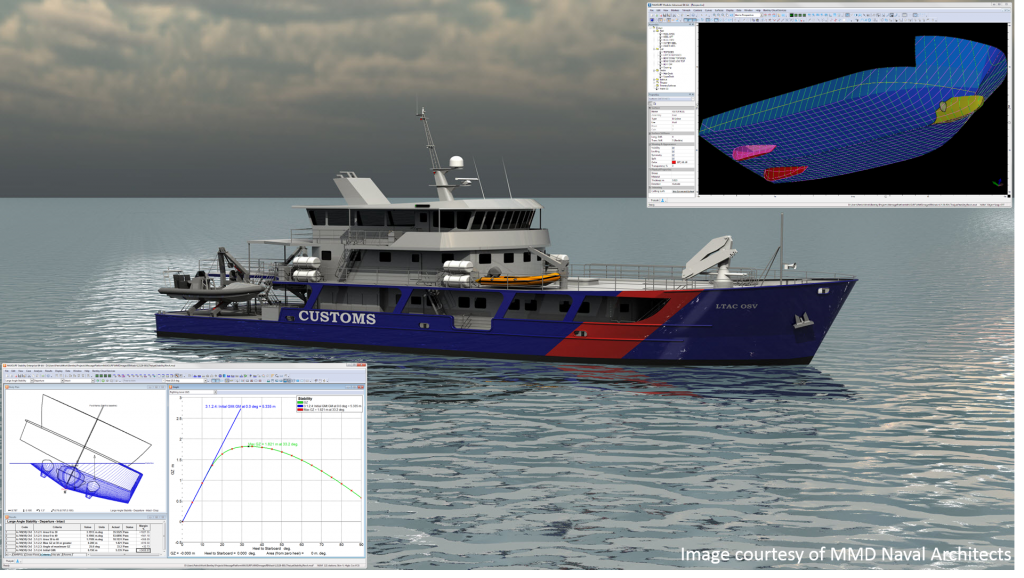This page has a brief note on the developments in each new release since January 2000.
For a more indepth explanation of progress since 2012 see Maxsurf Feature History
The current release is Maxsurf 2025 released June 2025
It is possible to specify which items should be included in the Stability report for each analysis mode (in previous versions of Stability, this could only be done with MS Word template document).
From the Report menu, select the Report Template dialog:
Report Template dialog
In the dialog, for each analysis mode (using the pull-down list), you can select which items appear in the report and in which order.

Maxsurf 2024 Minor 4 December 2024
New Features
This release of Maxsurf includes several new features requested by users including
Enhancements to the plots generated for envelope load cases.
Maximum allowable heel arm or moment analysis mode (e.g. Maximum allowable grain heeling moment). For selected criteria, compute the maximum heeling arm for a range of displacements and VCGs
DXF Export layer options: all geometry on single layer (new) or each geometry type on separate layer (old).
Tank Calibration: static fluid head to bottom of sounding tube.
Analysis ranges: specify a list of values for draft and displacement (instead of a range with common interval).
Enhancements to the Patch/Plate element edges release options to make it possible to release their rotational stiffness along an edge, effectively generating a hinged edge connection.

For a 3 minute video of the developments in 24.00.02 see here
Maxsurf and Multiframe 2024 Minor 2 July 2024
Tech.Preview: floating Stringers and stiffeners on Frames and Decks
New Features
This release of Maxsurf includes several new features requested by users including
- Automation API: XMLGrid class which allows you to extract data from any table in the Maxsurf applications
- Automation API: Structural parts in Maxsurf Modeler
- New automation samples using Python
- Signed distance from Marker to Surface in Maxsurf Modeler
- Selectable run conditions in Maxsurf Stability Batch analysis
- Sounding pipe and Key point rendering in Maxsurf Stability
- Print and DXF export of graphs to a measurable scale in Maxsurf Stability
- Replacement of RADIF panel method with MOSES solvers in Maxsurf Motions
Technology Preview
Find out more in this short YouTube video
Another area we have been working on is improvements to structural part modeling in Maxsurf Modeler. This includes several new features which are available in Technology Preview and we encourage you to try these and provide us with feedback so that we can develop these features to meet your needs.
DGN export including mesh representation of structure parts
Automation API: XMLGrid class which allows you to extract data from any table in the Maxsurf applications
Import of Room boundaries to Frame and Deck structure
Unconstrained Stringers (of arbitrary geometry, not confined to lie on a NURB surface)
Stiffeners on Frames and Decks

Main enhancements in Maxsurf 2024
Stability Probabilistic damage analysis, Final Equilibrium
The probabilistic damage analysis now provides the option of computing the vessel hydrostatics at the final equilibrium damaged waterline for each damage and loadcase combination. The results of these equilibrium analyses are shown in the new Probabilistic Damage Equilibrium results table. You may use the Display | Data Format dialog to select which columns are displayed; in addition to the standard Equilibrium analysis results you can also select to display the minimum freeboard of key lines and key points. The rows in this table have a 1:1 correspondence with the rows in the Probabilistic Damage results table.
Conditional flooding of Tanks and Compartments
The conditional flooding option has been extended to Tanks and Compartments (as well as non-buoyant Volumes as introduced in the previous version).
Modeler COM interface Automation
Quite a few additions have been made to the Modeler COM Automation interface – please refer to the ModelerAutomation.chm file installed with the application documentation for full details.
- Import and export of additional mesh formats including OBJ, OFF, and WAMIT
- Surface Meshing with greater control over mesh parameters
- Mesh repair
- Direct manipulation of NURB surface control point locations
- NURB surface bonding
Support lifecycle
Bentley Systems has made changes to the support lifecycle of desktop applications. One of the key changes is that major versions of Maxsurf will be supported with critical fixes for at least five years, although users are still encouraged to update to each new version to benefit from new features that are added to Maxsurf. These changes are detailed on the following web page: https://www.bentley.com/support/bentley-lifecycle-policy/
Maxsurf 2023 (23.07.00) from May 2023.
MAXSURF Advanced and MAXSURF Ultimate are now consolidated into a single product with all the capabilities and features.
This new product will be known as Maxsurf and will be under the MOSES Bentley Offshore brand.
Beginning with Maxsurf and Multiframe 2023, you will no longer have the option of selecting which license should be used to run the product because there is now only one option available.
Maxsurf 2023 (23.07) Developments include:
Surface continuity visualization with Zebra mapping
A zebra map render option is now available from the render dialog. Zebra mapping assists in visualizing the degree of continuity across surface bonds. Zebra Mapping generates extremely smooth NURBS surfaces using Zebra Mapping to identify areas of discontinuity/poor continuity
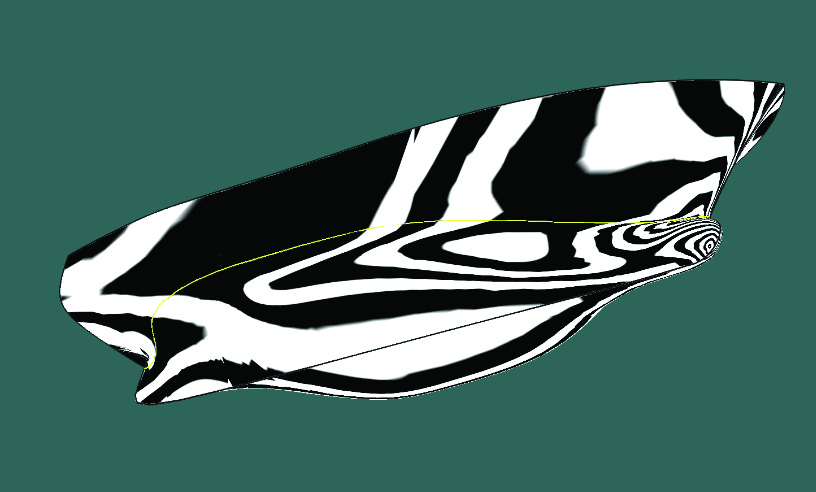
Conditional flooding of non-buoyant volumes
It is now possible to conditionally flood a Non-Buoyant Volume (NBV). Normally NBVs are permanently flooded, this new feature makes it possible to flood the BNV only when a specific Key Point is immersed. This feature can be used to model the flooding of a yacht’s cockpit for example.
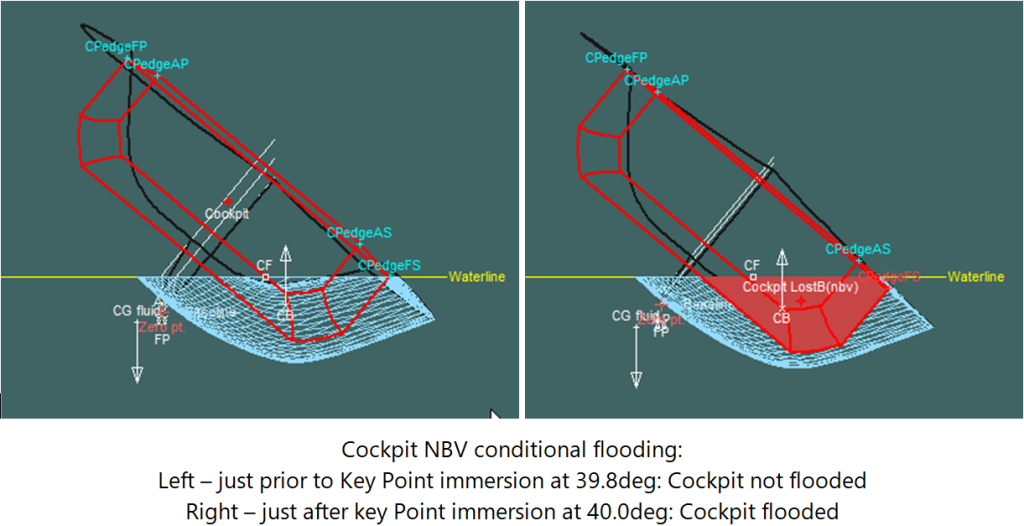
MAXSURF and Multiframe CONNECT Edition 23.06.00 (December 2022)
Here are some of the highlights in this update of MAXSURF:
- Modeler: Support for quad-dominant meshes.
- Modeler: Insert surface when bonding.
- Stability: Tank free-surface properties.
- Stability: Improved grounding calculation.
- and numerous minor enhancements
MAXSURF Version 23 update 5
Nesting (bin packing) of structural parts in Modeler
Quadrilateral elements in meshes in Modeler
IMS LPP files can be saved directly to files with .txt extension in Modeler
Improvements to the COM Automation interface for copying tables in Stability, Motions and Multiframe
The problem which caused a crash when opening some .skr files has been fixed in Motions
Improved modeling of rounded (filleted) patch corners in Multiframe
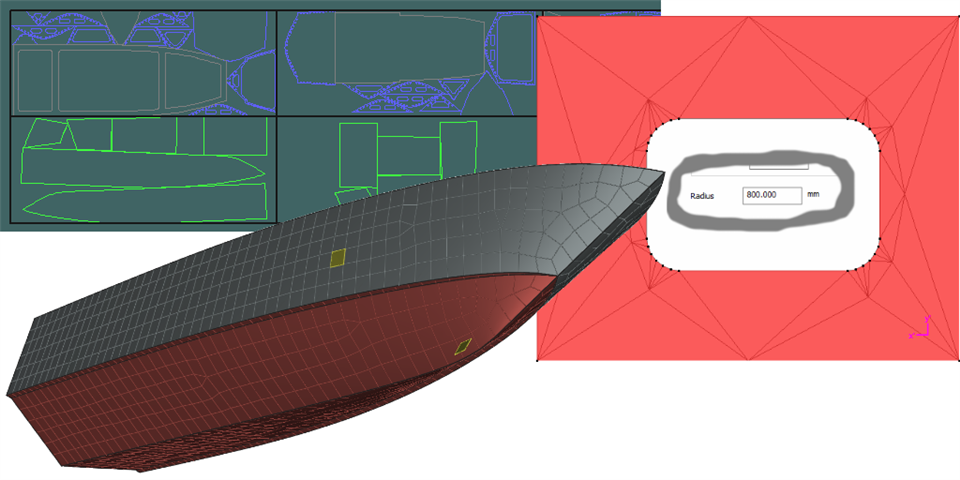
| MAXSURF and Multiframe CONNECT Edition 23.04… Some highlights In the 3D Perspective views, an option for automatically moving the view rotation centre to the middle of the screen has been added. This video highlights some enhancements we have made to the model rotation in the perspective window. In Stability we have added the so-called Tow Tripping heeling arm used in IMO MSC.415(97) Intact Stability code 2008 Part B, Chapter 2, §2.8.2.2 and BV NR 476.E1 Part E, Chapter 1, Section 2, §2.3.4. Furthermore two new stability criteria have been added: Angle of equilibrium is less that angle at which specified freeboard occurs as used in IMO MSC.267(85) Intact Stability code 2008 Part B, Chapter 2, §2.2.4.2 and NSCV Part C, Section 6A (Intact Stability) Chapter 7, §7.3.5.4 Angle of equilibrium is less that angle at which specified GZ occurs used in IMO MSC.415(97) Intact Stability code 2008 Part B, Chapter 2, §2.7.4.4 and BV NR 476.E1 Part E, Chapter 1, Section 3, §1.6.1.c The Ratio of Angle of Equilibrium now includes a Key Point emergence option. |
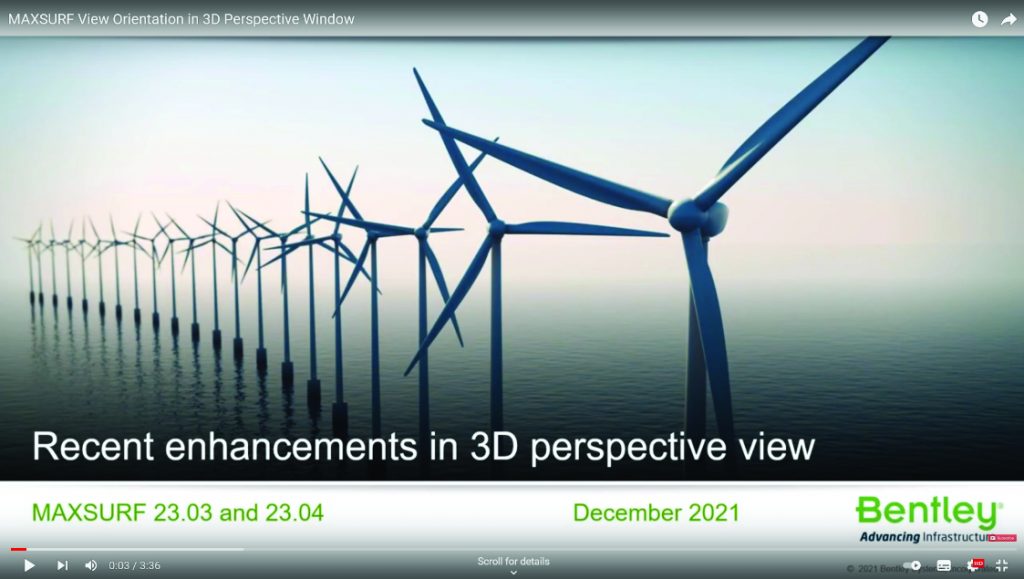
MAXSURF 23.03
Some improvements have been made to the virtual trackball used to change the view orientation in the perspective window and also the way the view orientation sliders work. In addition it is now possible to change the perspective field of view angle, allowing an isometric or fish-eye view to be shown in the Perspective window.
In MAXSURF Modeler, trimesh bonding has been simplified and it is now possible to select which trimeshes should be used to generate intersection lines with other trimeshes.
A feature providing a simplified way of generating 3- and 4-sided NURBS and trimesh surfaces from selected markers has been added.
The automation interface has been extended to include a wider range of trimesh functionality.
It is now possible to create parametric-based regular trimeshes from NURBS surfaces.
In MAXSURF Stability, we have added the updated STIX calculation described in ISO 12217:2-2021-07 4th Edition
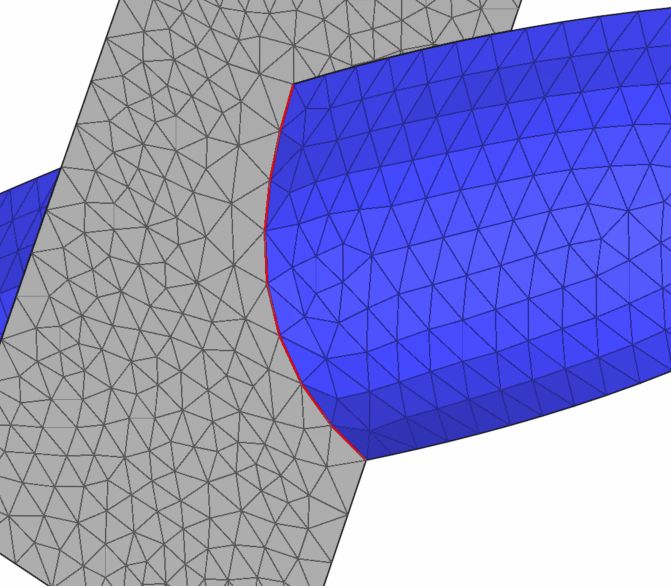
You may contact us for full details of each of the Release notes described
We also have a summary of the cumulative features added since v19 in 2013 in one document we can send to you or look further down here from rel 8 in 2000
| Release 23.01.00.117. Significant Changes Probabilistic Damage MSC.216(82) and MSC.421(98) There was an error in the way in which the probability of a damage condition occurring was calculated. This error occurred for conditions of multiple adjacent zones of damage and transverse subdivision when using the MSC.216(82) or MSC.421(98) methods. The error was that only the pFactor (due to longitudinal subdivision) were used when accounting for the probability of multiple adjacent zones being damaged. This is correct for the MSC.19(58) formulation, for cargo ships, where the p- factor and r- factor probabilities are independent, but is incorrect for MSC.216(82) or MSC.421(98) where the rFactor is dependent on the pFactor probability and so when considering multiple adjacent zones of damage the probability product p.r must be considered not the p- factor in isolation. The result was that the calculated probability of occurrence for conditions with multiple adjacent zones and transverse subdivision were in excess of what they should have been and this generally resulted in a (small) over estimate of the attained index, A. Please refer to the MAXSURF ReadMe for further information New Features Stability: Export/Import Table and Graph layouts from Data Format command. Stability: Modifiable Margin Line position. |
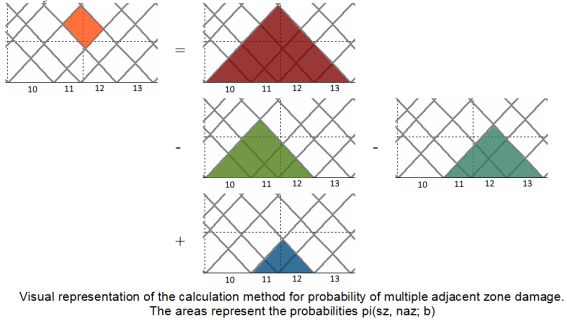
Release 23.00 December 2020
In this release of MAXSURF there are several enhancements to the MAXSURF modules particularly relating to modeling with Trimeshes. These include:
- Modeler: Trimesh repair and enhanced Boolean operations.
- Modeler: Trimesh primitive shapes – box, cylinder, column.
- Modeler: Trimesh triangle selection tools.
- Modeler: Improved performance for large models with complex trimming.
- Stability: New heeling arm and criterion.
- Stability: User-customizable criterion text.
- Stability: Calculation of freeboard at each heel angle (GZ analysis).
- Stability: Calculation of immersion angled at each displacement (KN analysis).
- and numerous minor enhancements
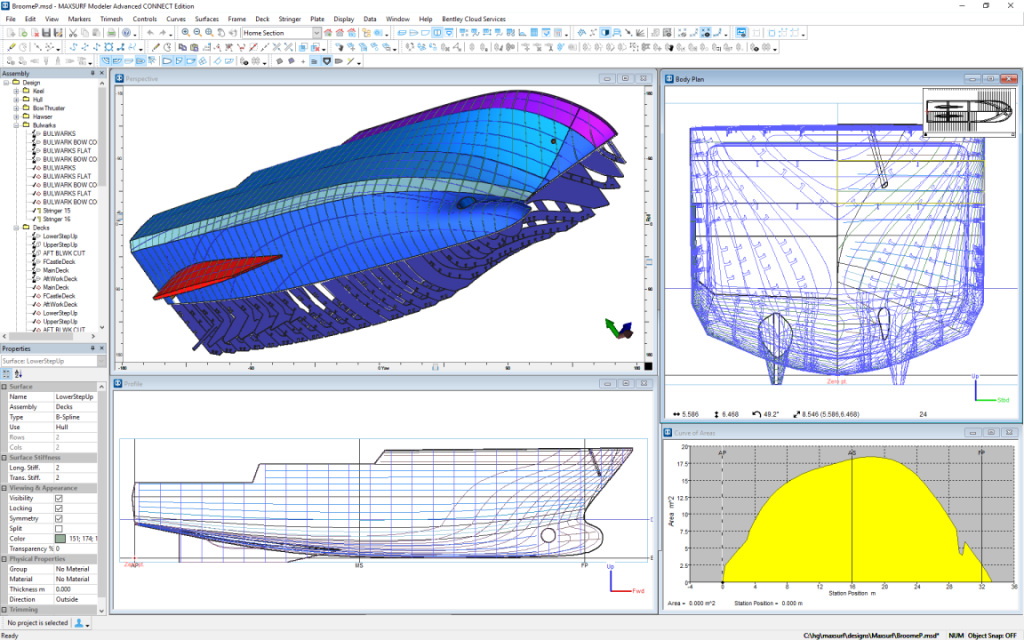
Release 22.03 March 2020
- Several New Trimesh Functions – these include extrude, split, assess quality, Boolean operations with groups of closed trimeshes including Union and Intersection, detailed trimesh statistics, trimesh standard shapes,
- Surface Trimming enhancements to simplify detailed models
- Structural Analysis Technology Preview
- COM Automation interface enhancements
- Motions – enhancements
- Multiframe Shape Editor enhancements
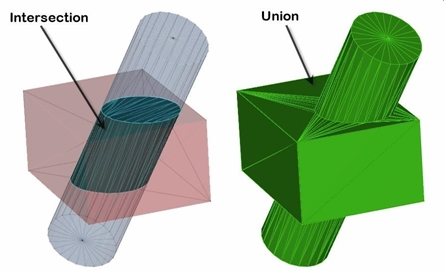
Release 22.01 April 2019
- Modal Analysis of Plate Structures
- Trimesh Bonding
- Point-cloud Filtering
- Technology Preview – IMO MSC.421 (98)
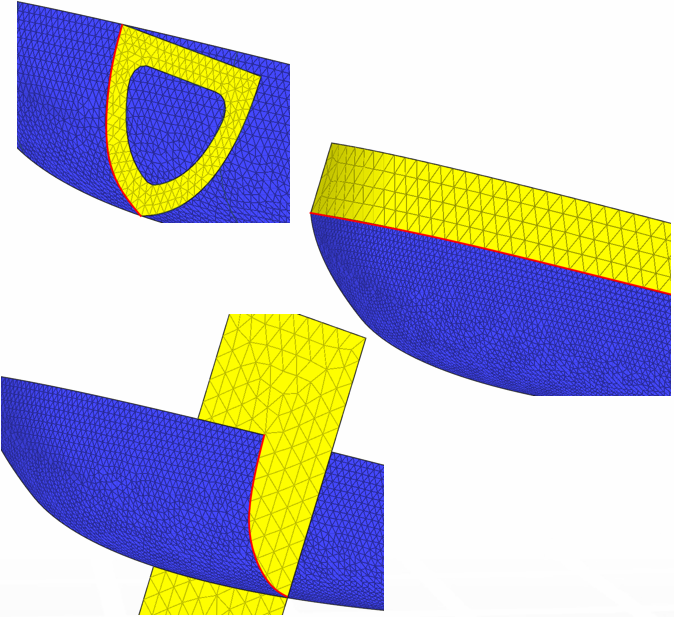
Release 22.00 (CONNECT Edition) December 2018
- CONNECT Licensing is Bentley’s new process for product activation, enhancing the users’ digital workflows and improving licensing capabilities:
- License alert notifications when you are approaching a custom usage threshold
- Replacing site activation keys with user validation, enhancing security around your Bentley licenses and subscriptions

Release 21.14 October 2018
- CONNECT Advisor improvements
- Generate Trimesh from any part
- Import/Export Trimeshes to Rhino 3DM
- Improved Trimesh bonding
- Stability Criteria EU Inland Waterways ES-TRIN 2017 – modifications made to existing criteria
- Contact us for full details of the appropriateRelease Note
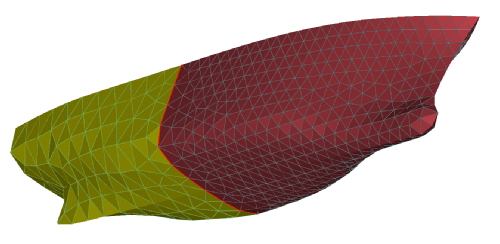
Release 21.13 July 2018
- One significant new feature is the ability to combine both NURBS and Trimesh surfaces in the same model and select which surfaces should be used for different analyses..
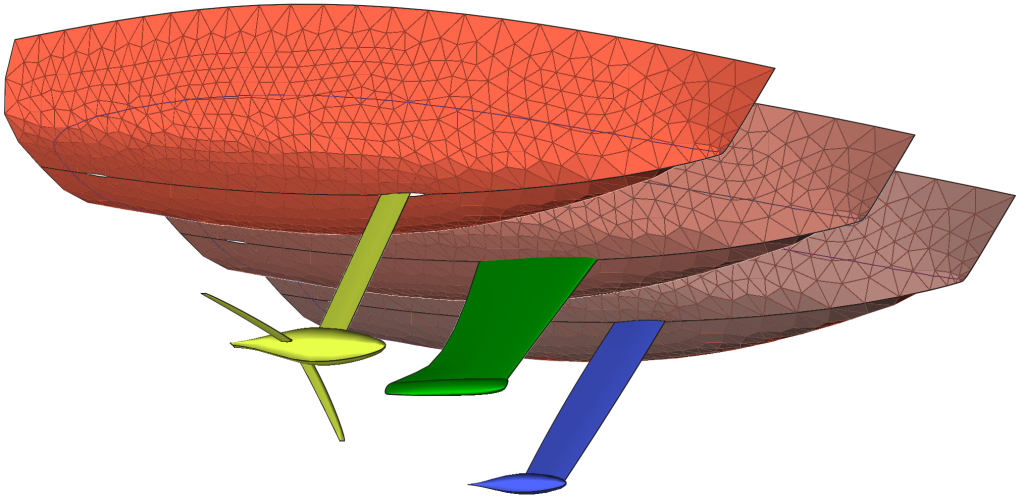
Release 21.12 March 2018
- Extended automation interfaces
- Intermediate stage damage
- Trimesh and NURBS transformation tools
Release 21.11 November 2017
- General updates
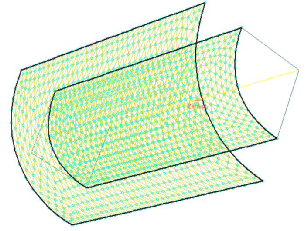
Release 21.10 August 2017
- CONNECT Edition Learning enhancements
- 64 bit versions only
- Improved render lighting – specular reflections
- New meshing functionality
- Structure functionality implemented in Modeler
- Probablistic damage case enhancement
- Multiframe precise circular patches or openings
Release 21.02 December 2016
- Stability Criteria – Roll-back to specified angle
Release 21.01 September 2016
- Simplified Trimesh Generation
Release 21 Oct 2015 MAXSURF CONNECT Edition
- Enhanced Trimesh Models
- Cross Flooding times, Tank Spilling
- Stability refinements with SQL database
- Multiframe ISM support
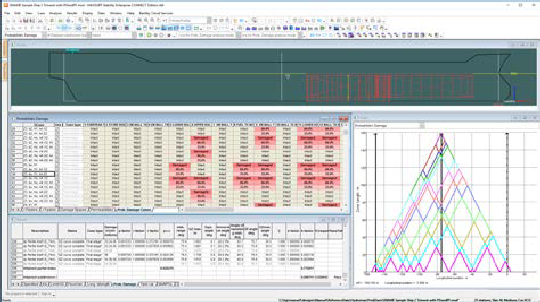
Release 20 Nov 2014
- Windage Surface Groups Definition
- New Marker Features
- Cargo Import Changes
- Korean Register Barge Resistance Algorithm
Release 19 Nov 2013
- Auto Ballasting in Stability
- Water on Deck improvements
- Automation updates in Stability
- Rider Bar enhancements in Structure
- Panel Method and Trimmed Vessel added to Motions
Release 18 Nov 2012
- Branding and Licensing changes
- Many developments – Stability
- Wyman Speed – Resistance
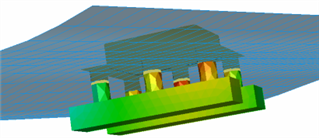
Release 17 Nov 2011
- Historical Vessels Sample Designs
- Stockholm Water on Deck
- Probablistic Damage Criteria Changes
- MARPOL and Criteria changes
- Workshop parts Rhino Data Exchange
- Plate meshing options
- Longitudinal Girder Enhancements
Release 16 Nov 2010
- 64 Bit versions
- Maxsurf Skinning enhancements
- Longitudinal Girder Flanges
Release 15 Dec 2009 – featuring EAS Brazil
- Probabilistic Damage Stability & Compartmentation Management
- Hydromax Ultimate
- Blount & Fox resistance
Release 14 Feb 2009
- Many many updates including surface types
- Additional heeling arms and criteria
- Max Safe Heeling for Sailing Vessels
- Stringers Broken at Frames
Release 13 Sept 2007 – featuring Southerly Designs
- 64-bit Support and new all-in-one installers
- Automated Surface Fitting for Stability Analysis
- Dynamic Trimming Enhancements
Release 12 Ma 2006 – featuring One2Three Naval Architects
- Parametric Transformation function updates
- Automated Generation of Production Drawings
- Enhanced Criteria Heelings Arms
- Round trip data exchange with Rhino
- New website resources: FAQ, Tips, Training, Manuals
Release 11
- Assembly Window
- Expanded Automation/VBA/Macro SUpport
Release 10 April 2004 – featuring DAMEN
- Multiple improvements including US Coastguard added to standard stability criteria
Release 9.5 Nov 2002 – featuring RNLI
- Advanced Stability Criteria – including IMO, SOLAS, HSC, STIX, MARPOL, USL, US NAVY
- Bonding with tangent continuity
- Selection of light sources in rendering
Release 9 Oct 2001 – featuring North West Bay Ships
- Improved surface trimming
- Numerical control point editing
- Curvature porcupines
- Batch Processing
Release 8.5 Mar 2001 – featuring Incat Designs
- Optimised Surface Fit from Table of Offsets
- Background images
- Assemblies
- Seakeeping visualisation
Release 8 Jan 2000
- New Plate Development Technology
- Multiple Damage Cases
- Standard Shapes, Improved Surface Management
- VRML – 3D for the internet
